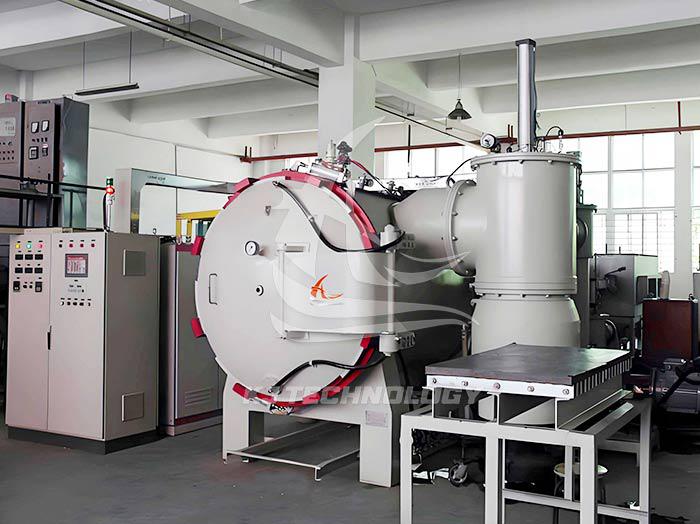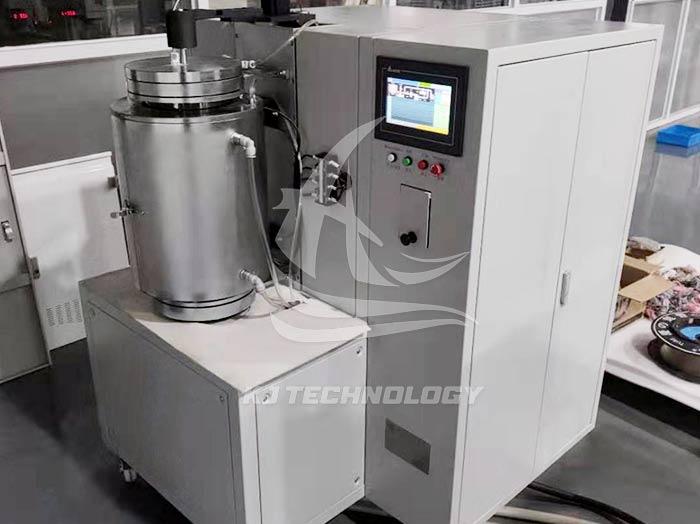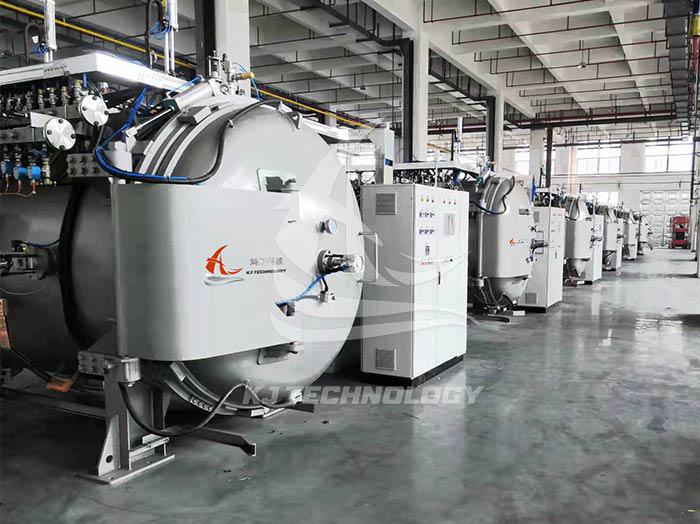Daily maintenance methods for high vacuum furnaces
 07-25-2025 Author: KJ technology
07-25-2025 Author: KJ technology
As a precision equipment, the daily maintenance of high vacuum furnaces is crucial for maintaining equipment performance, extending service life, and ensuring experimental/production safety. The following are systematic daily maintenance methods, covering key aspects such as cleaning, lubrication, inspection, and recording:
1. Daily maintenance
Furnace cleaning
Operation: After the furnace body has cooled to room temperature, use a vacuum cleaner or soft bristled brush to remove any residue (such as oxide scale, powder, debris) inside the furnace, and avoid using hard tools to scrape the inner wall (to prevent damage to the coating or heating element).
Attention: If the residue is molten metal or corrosive substance, it should be soaked in a special cleaning agent (such as dilute hydrochloric acid) and wiped, and immediately rinsed with clean water. After drying, it can be used.
Observation window cleaning
Operation: Dip a dust-free cloth in a small amount of alcohol or acetone, gently wipe the inner and outer surfaces of the observation window, remove fingerprints, oil stains, or deposits, and ensure clear visibility.
Attention: Avoid using cleaning agents containing abrasives or corrosive components to prevent scratching or damaging the optical coating.
Vacuum system inspection
Operation:
Observe the oil level of the vacuum pump (the oil mark should be between 1/2 and 2/3), and if the oil level is too low, replenish the same type of vacuum pump oil.
Check the oil quality: if the oil is muddy, black or has foam, it needs to be replaced immediately (usually every 200-300 hours of operation).
Listen to the sound of the vacuum pump running. If there is any abnormal noise or vibration, stop the machine and check if the bearings or blades are damaged.
Attention: When replacing the oil, the pump power should be turned off and the waste oil should be discharged after the pump body cools down to prevent burns.
2. Weekly maintenance
Sealing ring inspection and lubrication
Operation:
Check whether the sealing rings (such as fluororubber rings) on the furnace door, flange interface, and other parts are aging, cracking, or deformed. If there are any problems, they should be replaced in a timely manner.
Apply a uniform layer of vacuum silicone grease (such as Apiezon L or M type) on the surface of the sealing ring to reduce friction and enhance sealing performance.
Caution: Avoid using lubricants containing sulfur or chlorine to prevent corrosion of sealing materials.
Heating element inspection
Operation:
Visually inspect heating elements (such as tungsten wire, graphite tube, silicon molybdenum rod) for breakage, oxidation, or deformation.
Use a multimeter to measure the resistance value of the heating element. If the deviation exceeds ± 10% of the rated value, replace the element with a new one.
Attention: When replacing the heating element, power off and wear heat-resistant gloves to prevent electric shock or burns.
Cooling system inspection
Operation:
Check the inlet and outlet pressure gauges of the cooling water to ensure that the water pressure is between 0.1-0.3 MPa.
Touch the outer wall of the cooling water pipe to confirm that there is no local overheating or leakage.
Clean the cooling water filter to prevent impurities from blocking the pipeline.
Attention: In winter, it is necessary to ensure that the cooling water does not freeze (antifreeze can be added or the equipment can be kept running).
3. Monthly maintenance
Vacuum system leak detection
Operation:
Use a helium mass spectrometer leak detector to conduct leak testing on furnace bodies, vacuum pumps, valves, and other parts, with a focus on inspecting flange interfaces, welding seams, and sealing rings.
If a leakage point is found, it is necessary to tighten the bolts, replace the sealing ring, or re weld for repair.
Attention: Before leak detection, the pressure inside the furnace needs to be pumped to 10⁻³ Below Pa to improve detection sensitivity.
Electrical system inspection
Operation:
Check if the power and control wires are damaged or aged, and if the grounding wire is secure.
Use a megohmmeter to measure the insulation resistance of the equipment (should be ≥ 1 M Ω). If it is lower than the standard value, investigate the cause of leakage.
Clean the dust inside the electrical control cabinet to prevent short circuits or poor contacts.
Attention: Electrical inspection should be carried out by professionals to avoid the risk of electric shock.
Lubrication of moving parts
Operation:
Apply high-temperature lubricating grease (such as Molykote DX or 3 # lithium grease) to moving parts such as furnace door hinges, sliding rails, and transmission chains to reduce wear and ensure smooth switching.
Manually rotate the furnace door or transmission mechanism to confirm that there is no jamming or abnormal noise.
Caution: Avoid contaminating the vacuum system or heating elements with lubricating grease.
4. Quarterly and Annual Maintenance
Quarterly maintenance
Heating system calibration: Use standard thermocouples or infrared thermometers to calibrate the temperature controller, ensuring that the temperature display error is ≤± 2 ℃.
Vacuum pump maintenance: Disassemble the turbo molecular pump or diffusion pump, clean the blades and bearings, replace the lubricating oil, and clean the sediment in the pump chamber.
Annual maintenance
Comprehensive maintenance: Entrust a professional manufacturer to disassemble and inspect the furnace body, repair or replace aging components (such as heating chambers, vacuum valves, sensors, etc.).
Performance testing: Run standard process procedures to verify whether key indicators such as vacuum degree, temperature uniformity, and cooling efficiency meet the standards.
5. Maintenance records and archive management
Record content: The date, items, replaced parts, test data, and abnormal situations of each maintenance need to be recorded in detail.
Archive management: Establish equipment maintenance archives, archive records in chronological order, facilitate traceability of equipment historical status, and develop preventive maintenance plans.
6. Precautions
Safety first: Before maintenance, it is necessary to cut off power, gas, and drainage, and hang a "maintenance in progress" warning sign to prevent others from operating it incorrectly.
Professional training: Operators need to receive professional training, familiarize themselves with equipment structure and maintenance procedures, and avoid damage caused by improper operation.
Spare parts reserve: Reserve commonly used vulnerable parts (such as sealing rings, heating elements, vacuum pump oil) in advance to shorten downtime for maintenance.








